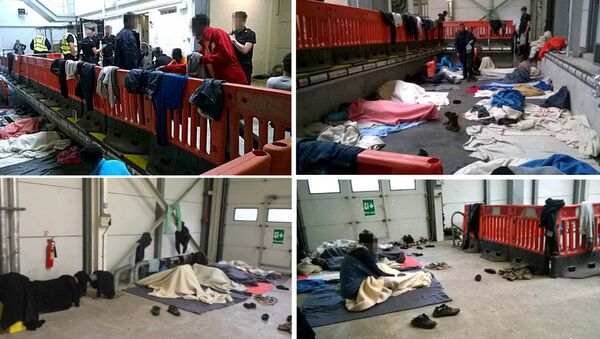Unannounced inspections of Dover Seaport, overspill center Frontier House, and Longport freight shed in Folkestone found that the three short-term holding facilities were detaining people overnight or for several hours without clean or dry clothes, food or hot drinks, despite arriving dehydrated.
The "clandestine migrants" held in these centers had hidden in vehicles on ferries between Dover and Calais or on trains in the Channel Tunnel — many of them had been living in makeshift camps near the port of Calais.
Longport Freight Shed
Immigration staff at Longport freight shed wore police-style fatigues, stab-vests and carried batons.
Stacked in a freight shed. This is one outcome of treating migrants as un-humans, as objects https://t.co/yRjBhdQxsJ
— Colin Yeo (@ColinYeo1) March 8, 2016
"Maybe David Cameron was not wrong when he suggested that loss of the UK's external border would lead to migrant camps in the south of England. We seem to be halfway there already," suggests Colin Yeo, immigration lawyer, writing on his Free Movement blog.Asylum seekers slept in wet clothes on concrete floors. It was also apparent that despite having heating, it wasn't switched on and detainees pointed to their open mouths when inspectors spoke to them — not one person had been offered a hot drink or food.
The freight shed located in a secure area next to the Eurotunnel terminal had previously been used by customs officials to search lorries, and had not been adapted to house detainees and "lacked even basic facilities."
From 31 August 2015 to October 2015, 569 people, including 90 children were detained in a "wholly unacceptable environment in which to hold people" in Longport freight shed which is managed by Home Office immigration staff that "hadn't been trained properly," according to Peter Clarke.
"The events of the summer and early autumn of 2015, in terms of the numbers of migrants arriving through the Channel Tunnel, were indeed unprecedented but… they were not unpredictable," said Mr Clarke who asks why contingency plans weren't put into place to cater for the number of migrants, "so that they could be treated in an appropriate manner."
Dover Seaport
Dover Seaport "was crowded and poorly ventilated and smelled badly" and "did not provide a safe environment for the detention of women and children," said Clarke. Detainees had to seek permission to shower, "which was an unnecessary restriction that impeded hygiene and decency," according to the report.
From November 2014, to September 2015 the number of unaccompanied children increased from 83 to 370 and many were found to be detained for "excessive periods."
Frontier House
Frontier House for adult males had no showers, no windows and nowhere to rest. Despite only being suitable for stays of a few hours only, some men had been detained there for more than 24 hours and all were handcuffed while being taken from an escort van to the detention center.
"This was particularly inappropriate in light of the fact that all were asylum seekers who were normally released shortly afterwards," the report states.
Ninety-seven percent of detainees in Longport freight shed were male — from 15 different countries, with Sudan, Eritrea, Afghanistan and Syria being the most common countries of origin.
During the three months between July and September 2015, 2,781 refugees, migrants and asylum seekers from 32 different were detained in Dover Seaport. Ninety-six percent were male, on average 24 years old. The majority of adult detainees were from Sudan, Eritrea, Syria and Afghanistan.
Dover Seaport and Frontier House are contracted out by the Home Office to Tascor, while the Home Office's Immigration Enforcement department runs Longport freight shed. The unannounced inspections took place in September and October 2015.




